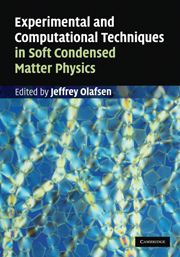Book contents
- Frontmatter
- Contents
- Contributors
- 1 Microscopy of soft materials
- 2 Computational methods to study jammed systems
- 3 Soft random solids: particulate gels, compressed emulsions, and hybrid materials
- 4 Langmuir monolayers
- 5 Computer modeling of granular rheology
- 6 Rheological and microrheological measurements of soft condensed matter
- 7 Particle-based measurement techniques for soft matter
- 8 Cellular automata models of granular flow
- 9 Photoelastic materials
- 10 Image acquisition and analysis in soft condensed matter
- 11 Structure and patterns in bacterial colonies
- Index
- References
8 - Cellular automata models of granular flow
Published online by Cambridge University Press: 05 July 2014
- Frontmatter
- Contents
- Contributors
- 1 Microscopy of soft materials
- 2 Computational methods to study jammed systems
- 3 Soft random solids: particulate gels, compressed emulsions, and hybrid materials
- 4 Langmuir monolayers
- 5 Computer modeling of granular rheology
- 6 Rheological and microrheological measurements of soft condensed matter
- 7 Particle-based measurement techniques for soft matter
- 8 Cellular automata models of granular flow
- 9 Photoelastic materials
- 10 Image acquisition and analysis in soft condensed matter
- 11 Structure and patterns in bacterial colonies
- Index
- References
Summary
Introduction
The modeling and simulation of granular materials is important to our understanding of their behavior and the wealth of phenomena they exhibit [1–3]. Many phenomena and practical applications, such as the design of industrial processes, remain out of reach of traditional simulation methods due to the large numbers of grains involved. A liter of fine sand, mgrain ≈ 0.1 mg, may contain 107 grains. An industrial process such as mixing or hopper flow can easily involve 101 to 103 liters. Geophysical processes, such as sand dunes and earthquake faults, involve even larger numbers of grains. Traditional simulation techniques are currently unable to deal with such large numbers of grains; however, cellular automata models are able to simulate larger numbers of grains for longer times and show promise in the simulation of large, real-world granular flows.
Molecular dynamics, where Newton's laws are applied to individual grains and the resulting motion is determined from the forces, has made dramatic progress in the past two decades through improved techniques and more powerful computers. Molecular dynamics is particularly effective for gases of simple grains interacting through hard-sphere collisions. In principle, even the physics of complex grain interactions can be included. However, as the complexity of the interactions increases or the number of grains increases, the computational demands increase as well. As a result, molecular dynamics is primarily used for relatively small numbers of grains (102–105), whereas real granular flows often contain many more.
- Type
- Chapter
- Information
- Publisher: Cambridge University PressPrint publication year: 2010



